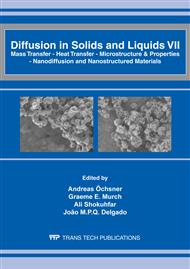p.573
p.578
p.583
p.587
p.593
p.599
p.605
p.612
p.620
Development of Nonlinear Analytical Models for the Study of Heat/Mass Transfer Properties in the Drying of Porous Type Fabric
Abstract:
Designing a drying process for porous type fabrics using traditional linear heat transfer models may be inefficiency because the drying characteristics in the process are usually nonlinear. Using nonlinear approaches to describe the heat/mass flow could be better for many industrial application cases. The paper as presented here is a study for an analytical model using differential form nonlinear equations to describe heat transfer and moisture diffusion process using air as the processing medium. Experimental findings were used to evaluate the performance of the studied model. Relationships between the model parameters and fabric physical properties were determined for further used in the design of drying equipment.
Info:
Periodical:
Pages:
593-598
Citation:
Online since:
April 2012
Authors:
Keywords:
Price:
Сopyright:
© 2012 Trans Tech Publications Ltd. All Rights Reserved
Share:
Citation:


